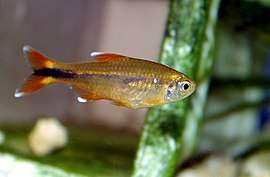Hasemania
Hasemania is a genus of characins endemic to Brazil, where only found in river basins that originate on the Brazilian Shield, ranging west to the Juruena system, north to the São Francisco system and south to the Paraná system.[1][2] The individual species generally have quite small ranges and two, H. crenuchoides and H. piatan, are considered threatened by Brazil's Ministry of the Environment.[3]
| Hasemania | |
|---|---|
 | |
| Hasemania nana | |
| Scientific classification | |
| Kingdom: | |
| Phylum: | |
| Class: | |
| Order: | |
| Family: | |
| Genus: | Hasemania Durbin, 1911 |
They are small fish, up to 2.7–7 cm (1.1–2.8 in) in standard length depending on the exact species.[1]
Species
There are currently 9 recognized species in this genus:[1][2]
- Hasemania crenuchoides Zarske & Géry, 1999
- Hasemania hanseni (Fowler, 1949)
- Hasemania kalunga Bertaco & F. R. de Carvalho, 2010
- Hasemania maxillaris Durbin, 1911
- Hasemania melanura Durbin, 1911 (Copper tetra)
- Hasemania nambiquara Bertaco & L. R. Malabarba, 2007
- Hasemania nana (Lütken, 1875) (Silvertip tetra)
- Hasemania piatan Zanata & J. P. Serra, 2010
- Hasemania uberaba J. P. Serra & Langeani, 2015
gollark: Yes. This is to prevent ΛK scenarios.
gollark: I fear this.
gollark: ... yes.
gollark: ++magic reload_ext userdata
gollark: ++userdata inc "atmospheric bee concentration"
References
- Froese, Rainer and Pauly, Daniel, eds. (2018). Species of Hasemania in FishBase. October 2018 version.
- Serra, J.P. & Langeani, F. (2015): A new Hasemania Ellis from the upper rio Paraná basin, with the redescription of Hasemania crenuchoides Zarske & Géry (Characiformes: Characidae). Neotropical Ichthyology, 13 (3): 479-486.
- ICMBio (Ministry of the Environment, Brazil): Portaria MMA nº 445, de 17 de dezembro de 2014. Lista de Especies Ameaçadas - Saiba Mais. Retrieved 1 December 2018.
This article is issued from Wikipedia. The text is licensed under Creative Commons - Attribution - Sharealike. Additional terms may apply for the media files.